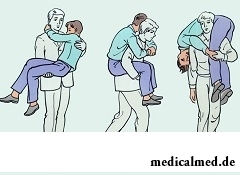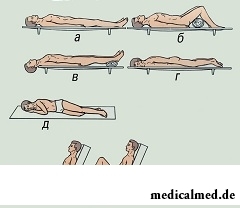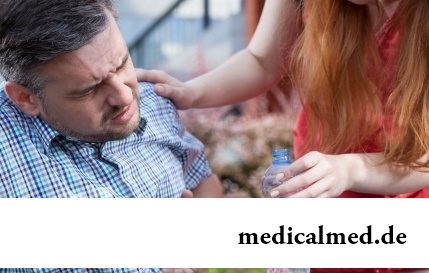





Transportation of victims
 At serious injuries, and also at suspicion of them, special attention is paid to transportation of victims as the wrong movement can aggravate an injury, having become an accessory disturbing factor. The recommendation of doctors is as follows: specialists therefore it is the best of all not to do it independently have to transport seriously injured person, and to call the ambulance. Unfortunately, not always it is obviously possible.
At serious injuries, and also at suspicion of them, special attention is paid to transportation of victims as the wrong movement can aggravate an injury, having become an accessory disturbing factor. The recommendation of doctors is as follows: specialists therefore it is the best of all not to do it independently have to transport seriously injured person, and to call the ambulance. Unfortunately, not always it is obviously possible.
It is necessary to transport the victim by own efforts in the following situations:
- Direct danger to life where there was an injury. For example, if the victim is on railroad tracks, in the burning building, the smoke-filled room, the building which can collapse at any time, etc.
- There is no opportunity to arrive ambulance.
In total allocate three types of transportation:
- Emergency. It is carried out in the presence of direct threat of life, as fast as possible, any suitable way of removal of the person from a dangerous zone to the next safe place is used. Such transportation can be very traumatic for the victim, but the purpose is rescue of human life therefore in this case neglect rules of movement of victims;
- Short-term. It is carried out by own efforts the people who are near the victim. In this case there is a need to choose an optimum method of movement of the victim whenever possible not to cause it discomfort, not to strengthen painful feelings, not to put a secondary injury. As a rule, in this case transportation is carried out not too far, and to the next place where can give to the person professional help or where he can wait for it in a safe situation;
- Long. Transportation by forces and means of specialists, the most convenient and safe for the victim. It is usually carried out after first aid on site and anesthesia.
In that case, when there is no an opportunity to arrive ambulance, long transportation should be carried out by forces of people around.
Recommendations about which the speech will go further intend for short-term transportation as in the conditions of modern life, as a rule, from nonspecialists it is required.
Preparation for transportation of victims
Being going to transport the person needing the help it must be kept in mind:
- The victim needs to be examined attentively to make idea of the nature of injuries. It is necessary to estimate a condition of a backbone, head, neck, thorax, stomach, pelvic area and extremities. Make sure that the person is in consciousness if he unconscious, it is necessary to check pulse and breath;
- If there is a suspicion on difficult character of injuries, the multiple combined injuries, the victim needs to be transported only as a last resort if there is no hope for arrival of ambulance. At such injuries it is necessary to move the victim whenever possible in that pose in which he is.
General rules of movement of victims
Rules and ways of movement of victims can differ depending on the nature of injuries (blood loss, changes, etc.), however there are several general principles:
- When transporting the person with an injury of cervical department of a backbone his head and a neck are immobilized, i.e. fixed to obstruct the traffic. In all other cases of the victim transport with the head turned on one side. It is necessary to avoid hit of emetic masses in respiratory tracts, and also asphyxia owing to retraction of language;
- The person with big blood loss is moved so that his legs were above the head. Such situation provides inflow of blood to a brain;
- At rise on a ladder, and also when placing in the vehicle of the victim bear the head, during descent and carrying out from transport forward – forward legs;
- The one who carries the victim ahead is appointed by the main thing, its task – to watch closely the road, to notice obstacles and to direct movement, coordinating actions of other rescuers (an example of team: "on three we lift a stretcher – time, two, three!"). At the same time to rescuers it is strictly forbidden to move "to a leg";
- The one who carries the victim behind watches his state, and in case of deterioration warns the others about need of a stop.
Types of transportation of victims depending on an injury and a state
 It was stated above that at the serious combined injuries of the victim should be moved without change of its situation. Now we will consider in what provisions it is necessary to transport victims in other, less difficult situations.
It was stated above that at the serious combined injuries of the victim should be moved without change of its situation. Now we will consider in what provisions it is necessary to transport victims in other, less difficult situations.
- Steady position on one side. In such pose victims in a case have to move:
a) vomiting attacks;
b) stays in unconsciousness;
c) at burns or other not getting injuries of the back side of a body (spin, a buttock, a back part of hips); - The sitting or semi-sitting position is applied in such situations:
a) neck injuries;
b) thorax injuries;
c) fractures of a clavicle, hands; - Dorsal decubitus with the raised legs:
a) injuries of an abdominal cavity;
b) suspicion of internal bleeding;
c) existence of big blood loss; - Dorsal decubitus with slightly moved apart legs and the roller ("a frog pose") enclosed under knees:
a) at spine injuries, injury of a spinal cord or suspicion of a similar injury;
b) at a change of pelvic bones or suspicion on it.
When transporting it is necessary to watch constantly a condition of the victim, remembering that it at any time can worsen. If it will occur, it is necessary to stop and begin to hold resuscitation events (breath of "companies in a mouth", "a mouth in a nose", an indirect cardiac massage). Resuscitation is carried out to appearance of the doctor or before recovery of breath and pulse.
Scientists from the Oxford university conducted a number of researches during which they came to a conclusion that vegetarianism can be harmful to a human brain as leads to decrease in its weight. Therefore scientists recommend not to exclude completely from the diet fish and meat.

All like to sing. Small children with pleasure are engaged in a vocal, not especially thinking of hit in a melody. Adults most often...
Section: Articles about health
Statistically, at the address to doctors seven of each ten patients complain of a headache. Actually it is much more people who are periodically feeling unpleasant feelings such. Many people, apart from a headache the reason for serious fear...
Section: Articles about health
Partial and the more so full loss of hearing significantly reduces quality of life. Difficulties with communication lead to loneliness and isolation. The person who badly hears experiences difficulties with social and professional implementation, quite often has problems in private life....
Section: Articles about health
The summer of this year in Russia was very ambiguous. Regions suffered from a merciless heat, from pouring rains, from times...
Section: Articles about health
It would seem, about it there can be no disagreements: water is necessary for a human body for normal life activity, and about how and when it should be drunk, all know. It turned out that the situation is not absolutely so: for many years occur ве...
Section: Articles about health
Residents of big cities quite often have a disease which is known as the syndrome of chronic fatigue (SCF) today. This illness affects the people belonging to various social and demographic groups and living on all continents. Most of all SHU are subject women aged from 25 up to 45 years. Statistically, the number of cases fluctuates in the different countries from 10 to 37 people on 100 thousand, but specialists believe that these figures are significantly underestimated as people, страдающ...
Section: Articles about health
Since the moment when the child becomes a school student, his sight begins to be exposed to the strengthened loadings which are supplemented viewing...
Section: Articles about health
The climax, or menopause is the normal process of the termination of genital function of the woman which is followed by serious hormonal changes in an organism. Usually the menopause begins at the age of 50-55 years, but characteristics of this process are very individual. T...
Section: Articles about health
Iodine - one of thirty most important microelements in our organism. The main role of iodine consists in synthesis of thyroid hormones of a thyroid gland - the substances which are responsible for the majority of exchange processes of an organism. It is known that thyroid hormones consist of iodine more than for 65%. The lack of iodine leads to decrease in production of hormones and, as a result, development of a hypothyroidism. The long condition of deficit can become a source of problems of the cardiovascular, bone, digestive SI...
Section: Articles about health
All are familiar with cold, and practically everyone believes that he has sufficient knowledge and experience that correctly to treat it. N...
Section: Articles about health
Olive oil – the product capable to make a powerful contribution to health of the person if it includes it in the diet. The rich vitamin composition of oil does it by a product number one from many diseases including from deadly. Only two tablespoons...
Section: Articles about health
There is an opinion that at low temperatures safety of products is ensured longer and better thanks to what the refrigerator is considered the most suitable place for storage of food. In most cases it is fair, however there is a number of products for which low temperatures – the main reason of their premature damage. Storage in the refrigerator leads to their bystry rotting, emergence of a mold, is followed by loss of vitamins and tastes. What products it is better to remove...
Section: Articles about health
Shops of household appliances offer us the huge choice of various devices for the house. Whether there are among this abundance devices which...
Section: Articles about health
All of us, unfortunately, should face flu nearly an every year. It would seem, so frequent disease has to be studied already up and down, and each person, at least once by it had (and the number of such people in our country aims at 100%), a dolzha...
Section: Articles about health
For the person who daily since morning gathers for work it is very important to wake up vigorous and ready by day of work. Actually, each of us experiences difficulties with this, at first sight, simple business from time to time. After night rest exert impact on a condition of an organism the weather which collected for several days fatigue, household and office problems, quality of a dream and many other factors....
Section: Articles about health
Producers of milk mixes for children assure: mixes are ideally balanced and adapted for needs of babies. In a sluch...
Section: Articles about health
Each of us faces from time to time that other people need the immediate help. We react to it differently: one at once call doctors and police, others rush to victims and try to save them independently. Some at all...
Section: Articles about health
The sclera and mucous membrane of an eye are intensively supplied with blood vessels which problem - to saturate nervous tissues of body with nutrients and oxygen. In a normality vessels are almost not noticeable, however at their expansion (owing to thinning of walls) become visible, painting a sclera in red color. Quite often red eyes - the signal of any trouble in an organism caused as external irritants, allergens, and diseases which need in about...
Section: Articles about health
About 10-15 years ago existence of the computer in the apartment of the Russian was considered as a rarity and office rooms were only on перв...
Section: Articles about health
The Genetically Modified Organisms (GMO) are plants or animals (as a rule, agricultural) to whose genotype purposeful changes were made. Opposition of supporters and opponents of inclusion of such organisms in foodstuff всег...
Section: Articles about health
Antibiotics - - it is possible to call the chemical compounds suppressing growth of bacteria the break in the field of medicine which allowed to save mankind from many diseases incurable earlier: tuberculosis, plague, syphilis and many others. The contribution of drugs to rescue of people from epidemics of dangerous infections is huge, however at careless use antibiotics are capable to cause to an organism serious damage. Negative action can be shown in the form of easing of immunity, disturbance of balance of microflora in кишеч...
Section: Articles about health
Almost each of us during life faced dissatisfaction with own body. At such moments, as a rule, we beginning...
Section: Articles about health
Subfebrile temperature call fervescence to 38 degrees, and subfebrile condition - existence of such temperature over 3 days, and quite often it happens without the visible reasons. Existence of subfebrile condition - a strong indication of disturbances in an organism which can...
Section: Articles about health
Run - one of the most available and effective ways to revitalize the organism. Knowing about its extraordinary advantage, each of us at least once tried to make jogs, but only the few made these occupations regular. In spite of the fact that in jogging (easy jogging), apparently, there is nothing difficult, the beginning runners often make mistakes which lead to complete cessation of trainings. Let's consider 10 useful tips for beginners who will allow them to make regular п...
Section: Articles about health
Within several decades of our compatriots convinced that the use of butter nasty affects on...
Section: Articles about health
Transfusion of donor blood has almost century history. In spite of the fact that this procedure is quite usual for many people, process of blood donation is still surrounded with numerous myths. Today we aimed to discredit the most widespread of them....
Section: Articles about health
Weakness of an ankle joint – very widespread problem. Its existence is demonstrated by tendency to a podvorachivaniye of legs when walking on heels, frequent painful sprains, pain on average and anonymous toes even after small loadings. Usually people with such pathology take off unpleasant effects by means of the anesthetizing pulverizing and ointments, but it does not lead to radical elimination of a problem. Meanwhile, at the known persistence it is possible to strengthen an ankle to the house...
Section: Articles about health
